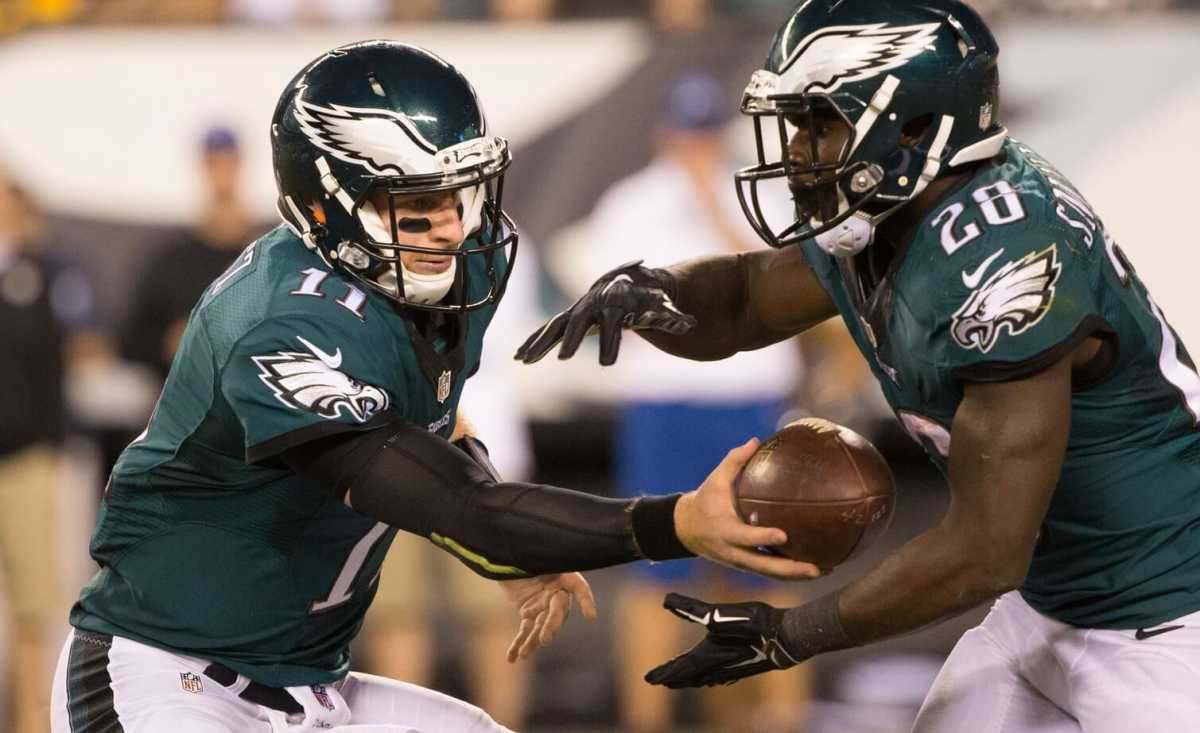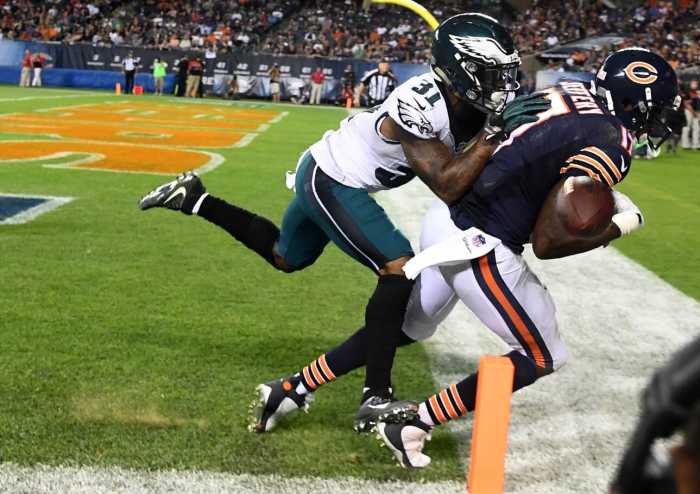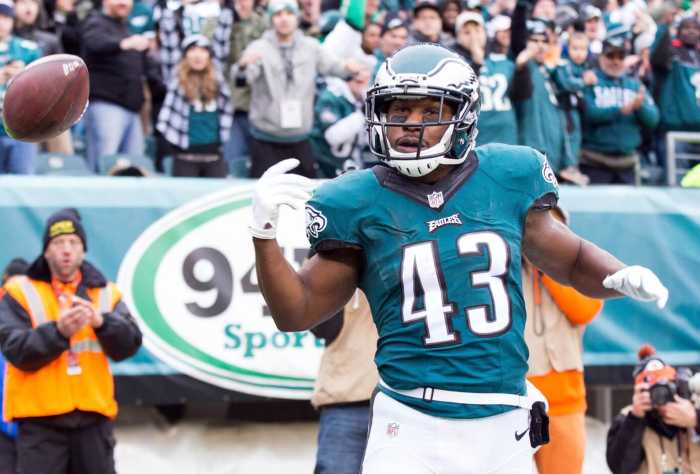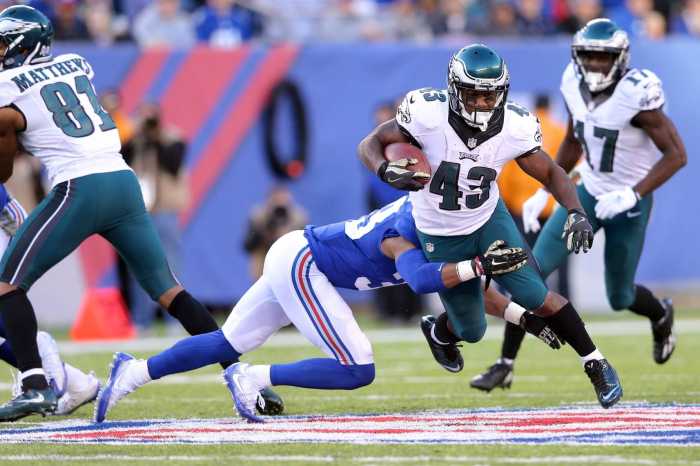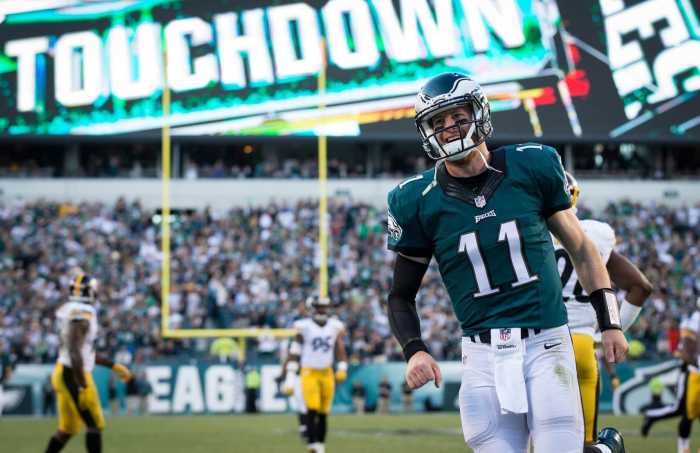Entering the offseason, the Eagles backfield faced numerous questions. With Darren Sproles announcing that he aims to retire at the end of next season, and there being no guarantee that Ryan Mathews returns from a neck injury, the Birds’ future on the ground seemed clouded. Many expected Howie Roseman and company to seek a talent such as Dalvin Cook, or Alvin Kamara, in the NFL Draft..but instead, they walked away with the most prolific rusher in FBS history, Donnel Pumphrey. The signing has caused plenty of debate..but the only discussion it should raise, is have the Eagles finally established a rushing identity?
Going into day three of the NFL Draft, Doug Pederson told the media exactly what it was he was looking for in a running back.
“..Going into it looking at three-down backs, number one, guys that can play obviously on all three downs, guys that, again, that are competitive, want to come in here and compete for the spot.” Eagles Head Coach Doug Pederson explained. “I mean, we still have some good backs on our roster with Wendell [Smallwood] and Darren [Sproles] and Ryan [Mathews], and so we’re looking to find that three-down guy, but at the same time, add talent at that position.”
As the only player in FBS history with at least 5,000 rushing yards and 1,000 receiving yards, Pumphrey shattered school records, passing Marshall Faulk’s records in his final season. With six 200+ yard rushing games under his belt and 14 of 150+, production is not something that evades Pumphrey..and it was just as prominent at the Senior Bowl, an even which as we all know by now, the Eagles love to pluck talent from. But is he the durable three-down back that Pederson envisioned? If he isn’t, history could be set to repeat itself.
Carson Wentz attempted 608 passes in his rookie season, while the Eagles backfield combined for a total of 381 carries. That does not scream consistency, nor does it scream balance. The only picture that it really does paint clearly is that the Eagles simply couldn’t figure out how to maximize the potential of such an elusive and dynamic unit. A unit, that they now simply have to utilize in 2017 if they are to be successful offensively.
Although the team ranked 10th in total rushing attempts, their nine fumbles ranked them T-6th in the league and their average of 4.1 yards per carry tanked them 18th. The backfield wasn’t completely ineffective in 2016. The Eagles still put up 1,813 total yards that was good enough to rank 11th in the league. The problem came with a failure to establish a consistent balance or utilize the many styles of back sat on the sideline.
Ryan Mathews burst out of the gate rushing for 77-yards against the Browns. But in week two, it was Darren Sproles who led the team in rushing, with 40-yards. A stark contrast perhaps foreshadowing the inconsistencies that were to follow.
What seemed like a new-found reliance on the lead backs saw the Eagles backfield pose less and less of a threat. Injuries crept up on them and it seemed like the complexion of the rushing attack would change on a weekly basis. From a complete committee effort one week, to lead backs being relegated to goal-line backs the next, the Eagles simply couldn’t find their identity. It felt as if they were trying to find a three-down back..but with so many hurdles to jump over, their path changed course.
Looking ahead to the 2017 season , the backfield has the same genetic makeup. Ryan Mathews and Darren Sproles are currently the two backs at the top of the pecking order, with last year’s fifth round pick, Wendell Smallwood just behind. After that, reports of Byron Marshall moving to WR, and the release of Terrell Watson, leave rookie Donnel Pumphrey, and undrafted rookie, Corey Clement on the roster.
While it’s unfair to compare the physical traits of Pumphrey and Sproles, you can certainly draw lines between their potential roles on the team. The elusiveness, size, and sheer burst of Pumphrey could see him as the perfect heir to the throne after the 13-year veteran bows out after an incredible career..but in terms of 2017, the Eagles first need to establish what Pumphrey can provide. While forcing over 200 missed tackles during his time at San Diego State, there are concerns that Pumphrey won’t be able to replicate that dominance at the NFL level..and it may take some experimenting from the Eagles to find out just how much of his video game skill set can transition to the pros. Experimenting that could see the Eagles tread on the same Coals as they did one year ago.
It would also be unfair to rest the entire hopes of the backfield on an undrafted rookie. But former Wisconsin Badger, Corey Clement, certainly sparks intrigue. Despite sharing the backfield with multiple rushers last year, he managed to rush for 1,375 yards and 15 touchdowns. Considered a bigger back at 5’11, 220 lbs, Clement was projected to go in the heart of the NFL Draft..but slipped right through the cracks in a deep running back class. If Clement can shine as the downhill runner he proved to be for the Badgers, then the Eagles could absolutely stride into 2017 with Clement heading the charge, with Smallwood readying to replace a between-the-tackles, zonal rushing role once held by Ryan Mathews, and Pumphrey learning from the best change-of-pace back in the game.
The future of Ryan Mathews has been in doubt for months, and with Darren Sproles retiring next season, the Eagles have over the last two years, drafted the two perfect replacements. Smallwood’s tough, yet elusive style emulates that of Ryan Mathews..and his average of 5.4 yards per carry against the Falcons exuded that template perfectly. For Pumphrey, the comparisons to Darren Sproles will seem endless..but if the production follows suit as it looks set to, then that’s really the only comparison worth noting. If the electricity Pumphrey brings to his team can transition to the NFL, just as it did for Darren Sproles, then the Eagles will have one of the most dangerous rushing attacks in the league for years to come, taking the template from the inherited backfield left behind by Chip Kelly..and expanding on it with some additions of their own.
In that scenario, the clouds seem to part much quicker. But as things stand, there is set to be heavy competition at the running back position. One spot where there is no competition after waiving Andrew Bonnet yesterday, is fullback. Arguably the missing link in Pederson’s West-Coast Offense, it’s a piece of the puzzle that simply hasn’t been found..and maybe the last.
Pederson: I like the fullback position. I'd like FB to be a four core special teams player. We'll look at Trey Burton there in the spring.
— Philadelphia Eagles (@Eagles) March 23, 2016
After being named the Philadelphia Eagles Head Coach, Doug Pederson seemed keen to implement a fullback in his offense and despite numerous candidates, from Trey Burton, to Chris Swain, Andrew Bonnet and Ryan Meueller, they simply never found an answer. 3-TE sets were an integral part of the Eagles rushing attack last year..but after one full season with the team and two offseason’s, the Eagles have optionally passed on adding a fullback to fill that void. Perhaps it’s not as high on Pederson’s priority list as we once thought..but again, it’s something that has slipped under the radar untouched.
There is of course the possibility that the Eagles sign one of the remaining free agent backs available, or begin to pursue trade options after the fortunes of some changed following the NFL Draft. From the idea of trading for Tevin Coleman or Terrance West, to the thought of acquiring LeGarrette Blount on a short-term deal, the Eagles could find a certain answer in the way of a workhorse back on a prove-it deal, but due to the nature of the Eagles offseason, it would probably go against their best interests to add another bandaid veteran, and instead look to build through the draft as Joe Douglas intended.
When you look at it through that lens, the Eagles may have patched the inconsistencies of last season by simply doubling down on their current corps. Maybe what set them back after all wasn’t the rushing talent itself, but the way it was, or in this case wasn’t utilized. By adding even more explosiveness, durability, and versatility, it’s a rushing effort by committee once again for the Eagles..and that’s all Doug Pederson needs to help his quarterback flourish.
It doesn’t matter if Donnel Pumphrey carries the ball two times per game, or if he rushes it twenty. If he can impact the game that the Eagles believe he will, if Smallwood can continue to grow as he did in 2016, and if Corey Clement can overcome his own character issues and thrive under the spotlight of competition..the Eagles have their backfield not only for 2017, but for many seasons to come.
Mandatory Credit: Bill Streicher-USA TODAY Sports

